|
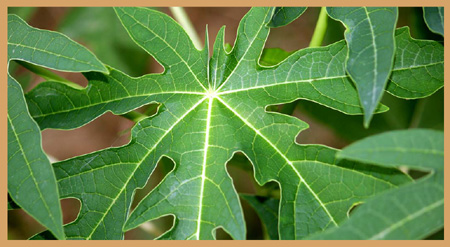 Papaya is considered one of the most economically important and
nutritious fruits, being a rich source of antioxidant nutrients
such as carotenes, vitamin C and flavonoids; the B vitamins
folate and pantothenic acid; the minerals potassium, magnesium
and fiber. Papaya is considered one of the most economically important and
nutritious fruits, being a rich source of antioxidant nutrients
such as carotenes, vitamin C and flavonoids; the B vitamins
folate and pantothenic acid; the minerals potassium, magnesium
and fiber.
Integrated Nutrient Management
For papaya, fertilizers should be applied once in every
two months. Although fertilizer application in a particular
region depends on the soil and leaf analysis, generally 90 g of
Urea, 250 g of Super phosphate and 140 g of Muriate of Potash
per plant are recommended for each application. Total
requirement is 250 g N + 250 g P2O5 + 500
g K2O per plant/year. Application of 7-10 kg farm
yard manure / plant every six months is recommended in addition
to fertilizers. The leaf analysis technique for papaya has also
been standardized and recently matured 11th leaf
petiole was found optimum. Fertigation also can be followed with
soluble fertilizers, which save about 25-30% fertilizers. Apply
100% recommended N and K fertilizers through drip irrigation (50
g N and 50 g K2O) in addition to soil application of
50 g P2O5 at bimonthly interval.
Nutrients removed by Papaya
Papaya has three distinct development phases:
(1) Initial
growth; (2) Flowering
and fruit formation; (3)
Production.
Papaya takes up relatively large quantities
of nutrients and the demand continues until the plants are about
one year old. Because harvests are intermittent from the start
of production, the plant needs frequent applications of water
and nutrients to ensure the continuous production of flowers and
fruits.
Percentage distribution, during the development of papaya, of
the total nutrients in the crop at the end ofthe first year of
growth, based on the rate of nutrient absorption estimated at
IIHR and nutrient uptake by two year old whole plant of papaya.
|
Crop Stage |
N |
P |
K |
S |
Ca |
Mg |
Fe |
Mn |
Zn |
Cu |
B |
| Vegetative Grand
growth stage |
1.6 |
2.9 |
3.5 |
2.8 |
3.8 |
3.1 |
4.6 |
4.0 |
6.3 |
5.1 |
6.0 |
| Flowering
and fructification |
19.2 |
21.3 |
21.2 |
22.4 |
26.4 |
24.1 |
27.6 |
20.4 |
28.9 |
24.3 |
31.5 |
|
Fruit production (harvest) |
37.1 |
33.5 |
33.3 |
33.0 |
41.2 |
37.3 |
34.6 |
38.3 |
37.5 |
33.8 |
39.7 |
|
Nutrient uptake by two year old
whole plant of papaya |
Nutrient status
Nitrogen (N):
 Second
only to potassium, nitrogen is the most used nutrient in papaya
growth, development and fruit production. Regardless of soil,
cultivar and climate the total nitrogen taken up by papaya is
related to the total dry matter production. Nitrogen is
considered to be in short supply even when the crop is grown on
highly fertile soils. Required for vegetative growth, N should
not be limiting in the first 5 to 6 months after planting.
Symptoms of N deficiency appear first in the mature
leaves, which have yellowish areas between the veins. Later,
these leaves become yellow, aged and stands out from the trunk,
and may even become necrotic with the centre turning brown and
the edges purple Second
only to potassium, nitrogen is the most used nutrient in papaya
growth, development and fruit production. Regardless of soil,
cultivar and climate the total nitrogen taken up by papaya is
related to the total dry matter production. Nitrogen is
considered to be in short supply even when the crop is grown on
highly fertile soils. Required for vegetative growth, N should
not be limiting in the first 5 to 6 months after planting.
Symptoms of N deficiency appear first in the mature
leaves, which have yellowish areas between the veins. Later,
these leaves become yellow, aged and stands out from the trunk,
and may even become necrotic with the centre turning brown and
the edges purple .
When N deficiency is severe, all of the leaves turn yellow, new
leaves have slimmer stems and leaf laminas are not well
developed. Application of excess N without balancing amounts of
P and K would result in over vegetative growth, with a greater
distance between fruits on the trunk and inconsistent quality of
the pulp. The TSS of the fruit pulp reduces and the fruit become
over soft on ripening. .
When N deficiency is severe, all of the leaves turn yellow, new
leaves have slimmer stems and leaf laminas are not well
developed. Application of excess N without balancing amounts of
P and K would result in over vegetative growth, with a greater
distance between fruits on the trunk and inconsistent quality of
the pulp. The TSS of the fruit pulp reduces and the fruit become
over soft on ripening.
Phosphorus (P): Although it is the
macro-nutrient, this is required in very low quantity.
Absorption by the plant increases uniformly during growth and is
most important during initial root development. Thus it is
necessary to give the young plants a source of readily
plant-available P. It is also suggested that P has an effect on
setting the fruit.  Hence
basal application of phosphorus helps in better crop
establishment. The deficiency of P causes reduced leaf
production, complete cessation of elongation and older leaves
becoming increasingly irregularly necrotic. P deficiency causes
a blue or dark green coloration of leaves. Marginal chlorosis
and premature death are also caused. P deficient trees bear
fewer fruits and hence also suggested that P has an effect on
setting the fruit. Hence
basal application of phosphorus helps in better crop
establishment. The deficiency of P causes reduced leaf
production, complete cessation of elongation and older leaves
becoming increasingly irregularly necrotic. P deficiency causes
a blue or dark green coloration of leaves. Marginal chlorosis
and premature death are also caused. P deficient trees bear
fewer fruits and hence also suggested that P has an effect on
setting the fruit.
 Plants
raised on P deficient nutritive solution resulted in P
deficiency symptoms initially in the oldest leaves, which have
amottled yellow color along the edges. As deficiency progresses,
the yellow areas become necrotic and the leaves have pointed
lobes while the edges curlupwards. Later, the leaves turn
completely yellow and fall from the trunk. New leaves are
smaller and have a dark green coloring. Plants
raised on P deficient nutritive solution resulted in P
deficiency symptoms initially in the oldest leaves, which have
amottled yellow color along the edges. As deficiency progresses,
the yellow areas become necrotic and the leaves have pointed
lobes while the edges curlupwards. Later, the leaves turn
completely yellow and fall from the trunk. New leaves are
smaller and have a dark green coloring.
Potassium (K): Among the nutrients the
requirement of potassium is the largest. Papaya takes up K
continuously throughout the entire plant cycle. It is especially
important after the fertilization of the flowers to produce
larger, better quality fruit, with elevated levels of sugars and
total soluble solids.
 A
ratio of N:K2O of 1:1 seems to be the most favorable
to obtain good yields,which suggests that the fertilizers used
should have N:K2O ratios close to 1:1. Potassium
deficiency appears first in the oldest leaves and under severe
deficiency the leaves are shed resulting in a decrease in their
number and the remaining leaves positioned obliquely to the
trunk. A
ratio of N:K2O of 1:1 seems to be the most favorable
to obtain good yields,which suggests that the fertilizers used
should have N:K2O ratios close to 1:1. Potassium
deficiency appears first in the oldest leaves and under severe
deficiency the leaves are shed resulting in a decrease in their
number and the remaining leaves positioned obliquely to the
trunk.
 Deficiency
results in marked reduction in growth, leaves profusely smaller,
leaf margins necrosis and premature yellowing of plant. Purplish
brown patches appear at the base of the petioles. Fruits are
badly shaped, poorly filled and unsuitable for marketing. Deficiency
results in marked reduction in growth, leaves profusely smaller,
leaf margins necrosis and premature yellowing of plant. Purplish
brown patches appear at the base of the petioles. Fruits are
badly shaped, poorly filled and unsuitable for marketing.
 The
oldest leaves may also become yellow between the veins and
along the edges with a slight marginal necrosis on the
extremities of the lobes. The leaves tend to dry from the tip to
the centre. The developing leaves show chlorotic edges with
small necrotic spots. When K deficiency is severe the growing
point is affected The
oldest leaves may also become yellow between the veins and
along the edges with a slight marginal necrosis on the
extremities of the lobes. The leaves tend to dry from the tip to
the centre. The developing leaves show chlorotic edges with
small necrotic spots. When K deficiency is severe the growing
point is affected
Calcium (Ca): It is the third most required
nutrient and it also accumulates uniformly like potassium.
Calcium deficiency causes aninitial chlorosis of recently
mature leaves which have curled edges, harming leaf development
with small necrotic spots spread overthe leaf lamina.
  This
chlorosis extends back to the youngest leaves and the affected
leaves have twisted and folded stems. Calcium deficiency is also
responsible for premature ripening of fruits on the tree leading
to loss of fruits and softening of the fruit pulp, which results
in problems in transport and a short commercial shelflife. This
chlorosis extends back to the youngest leaves and the affected
leaves have twisted and folded stems. Calcium deficiency is also
responsible for premature ripening of fruits on the tree leading
to loss of fruits and softening of the fruit pulp, which results
in problems in transport and a short commercial shelflife.
Magnesium (Mg): Magnesium is emerging as a
limiting nutrient in papaya cultivation especially on red
soils.
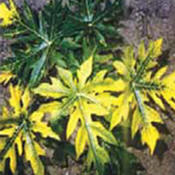 The
reasons for the emergence of magnesium deficiency in papaya is
both soil and plant based problems. Soil magnesium levels are
depleting without external additions. Fertilizer application
pattern skewed towards potassium causes imbalance between Mg and
K. This is a major reason for the appearance of Mg deficiency
in papaya. The
reasons for the emergence of magnesium deficiency in papaya is
both soil and plant based problems. Soil magnesium levels are
depleting without external additions. Fertilizer application
pattern skewed towards potassium causes imbalance between Mg and
K. This is a major reason for the appearance of Mg deficiency
in papaya.
 Intensive
cultivation with high yield targets through modified fertilizer
application through drip using Mg free fertilizers fails to meet
the Mg requirement of the plants leading to Mg deficiency.
Magnesium deficiency results in the mature leaves having an
intense yellow color, while the regions in the proximity of the
veins remain green. When Mg is very deficient, the new leaves
also have similar symptoms. Intensive
cultivation with high yield targets through modified fertilizer
application through drip using Mg free fertilizers fails to meet
the Mg requirement of the plants leading to Mg deficiency.
Magnesium deficiency results in the mature leaves having an
intense yellow color, while the regions in the proximity of the
veins remain green. When Mg is very deficient, the new leaves
also have similar symptoms.
Sulphur (S): Sulphur is a component of papain,
a proteolytic enzyme, and, in general, performs functions in the
plant that affect yield and quality of the fruit.
 When
sulphur is deficient, new, expanding leaves are light green in
color before becoming uniformly yellow. With increasing
deficiency, the completely expanded leaves also become yellow.
Before the appearance of visual symptoms in the leaves, the
growth of the papaya plant is affected. Sulphur uptake may also
be affected by the presence of chloride ions added to soil in
fertilizer. When
sulphur is deficient, new, expanding leaves are light green in
color before becoming uniformly yellow. With increasing
deficiency, the completely expanded leaves also become yellow.
Before the appearance of visual symptoms in the leaves, the
growth of the papaya plant is affected. Sulphur uptake may also
be affected by the presence of chloride ions added to soil in
fertilizer.
Management of sulphur in
papaya: Papaya is
generally grown in the humid tropics with typically high annual
rainfall and free draining soils. Because sulphur is
predominately found in the anion form (SO4), which is
easily leached under such conditions, a regular supply is
required to maximise productivity. In many soils, a crop’s
requirement for S is supplemented by a natural source coming
from organic matter but since our soils are typically poor in
organic matter the S requirement far exceeds the natural supply.
The data base of Indian soils on availability of sulphur is very
poor. But, our soils are generally poor in sulphur supply.
Fertilizers containing sulphur like sulphate of potash and
single super phosphate and amendments like gypsum and pyrites
may be used for growing papaya in acidic and highly leached
soils. Judicious application of organic matter takes care of the
sulphur requirement of the crop. However, a general application
of 20 to 40 kg sulphur indirectly through P or K fertilizers or
as gypsum or pyrite may be done in growing papaya on light
textured soils.
Zinc (Zn): Zinc acts as a cofactor of enzymes
and is involved in the production of growth regulators
responsible for the internode elongation and chloroplast
development. Zinc deficiency significantly reduces growth and
yield potential of papaya.
 Low
zinc levels also reduces fruit number per tree and to a lesser
extent the fruit size, resulting in decreased yields. Zinc
deficiency is seen in the expanding leaves as interveinal
chlorosis that later become purple spots. Low
zinc levels also reduces fruit number per tree and to a lesser
extent the fruit size, resulting in decreased yields. Zinc
deficiency is seen in the expanding leaves as interveinal
chlorosis that later become purple spots.
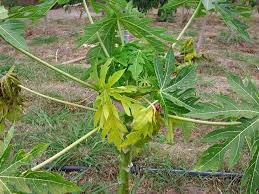 With
increasing deficiency, the youngest leaves remain small,
possibly showing necrosis along the edges and on the lamina
between the principal veins. The internodal space is also
shortened. Zinc deficiency included pronounced raised light
green veins on the upper and lower leaf surface distorted strap
like leaf lobes and slight yellowing of youngest leaves. With
increasing deficiency, the youngest leaves remain small,
possibly showing necrosis along the edges and on the lamina
between the principal veins. The internodal space is also
shortened. Zinc deficiency included pronounced raised light
green veins on the upper and lower leaf surface distorted strap
like leaf lobes and slight yellowing of youngest leaves.
Management of zinc in
papaya:
Fertilizing papaya with zinc containing chemicals is
uncommon. However, those farmers who are applying zinc as
fertilizers to soils have continued to apply every year leading
to accumulation of high levels of zinc in such soils. This
has caused imbalance in plant nutrition leading to induced
phosphorus and other deficiencies.
Keeping this in mind and the pattern of fertilizer use in papaya
and the crop ability to absorb nutrients it is advisable to go
for foliar application of zinc rather than soil application as a
precaution to avoid unnecessary accumulation in the soils
leading to nutrient imbalances. A general spray of 0.25 to 0.40%
solution of ZnSO4.7.H2O would take care of
the zinc requirement of papaya. Use of Arka papaya
micronutrient formulation developed by IIHR, Bengaluru @2g per
litre
meets the micronutrient requirement of papaya including
zinc.
Manganese (Mn): Manganese deficiency is not
common in papaya. Under deficiency there will be marginal
chlorosis of young leaves, which later turn brown. Leaves give
striped appearance from the edges.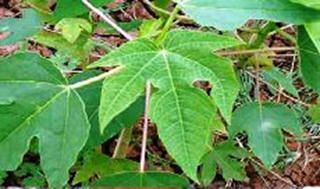 Leaves also show typical gallery type interveinal chlorosis on
younger and recently mature leaves.
Leaves also show typical gallery type interveinal chlorosis on
younger and recently mature leaves.
 Leaves
desiccate prematurely causing poor fruit development. Manganese
supply is very restricted under dry conditions. If plants face
manganese deficiency, under such circumstances, normal size
fruit is produced by the plant but the fruits are covered with
raised dark brown or black spots. Leaves
desiccate prematurely causing poor fruit development. Manganese
supply is very restricted under dry conditions. If plants face
manganese deficiency, under such circumstances, normal size
fruit is produced by the plant but the fruits are covered with
raised dark brown or black spots.
Management of manganese in
papaya:
Manganese deficiency in papaya being uncommon, farmers
do not apply manganese to papaya crop. Since papaya growing
regions are well supplied with soil Mn, it is also advised not
to render to soil application of Mn. Only if need arises by way
of expression of deficiency symptoms growers may undertake
foliar application of Mn. Though rare, if deficiency appears
during dry period a simple spray of 0.2% MnSO4 will
correct the deficiency .
Copper (Cu):
Copper
deficiency in papaya is not reported in India. This is mainly
because the soils of papaya growing regions are well supplied
with copper and further to this many of the agrochemicals and
organics added to papaya contain sufficient copper to meet the
copper requirement of the crop. However, if papaya is grown in
high organic matter soils and peat soils, under such situations
papaya can show copper deficiency. Deficient papaya plant show
midrib and main veins bending backwards giving plant an umbrella
appearance. Leaves turn to a yellow bronze color. Cu toxicity is
possible, in particular where copper oxichloride and Bordeaux
mixture are in use for plant protection.
Management of copper:
Copper is not
reported as deficient in any of the papaya growing regions.
Hence copper application to papaya may be avoided. Sufficient
copper is supplied to crop through the addition of organic
matter and also through the copper containing fungicides and as
a contaminant with other agrochemicals. Hence soil application
of copper to papaya may be avoided.
Iron (Fe):
Iron deficiency appear first on younger leaves and expressed as
gradual interveinal chlorosis and stunted growth.
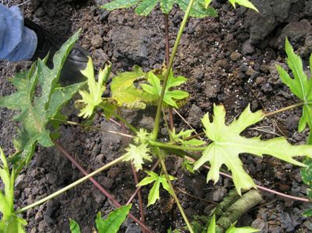 Leaves
may become yellow-white. The chlorosis is more acute in the
months of March-April and continues till rains are received and
may reappear after soils dry in post monsoon period before onset
of winter. In most of the areas deficiency gets corrected
during rainy season. It is also expressed on trees grown on
alkaline and calcareous soils soon after rains after a dry spell
because of increase in the bicarbonate content in the soil
solution. Leaves
may become yellow-white. The chlorosis is more acute in the
months of March-April and continues till rains are received and
may reappear after soils dry in post monsoon period before onset
of winter. In most of the areas deficiency gets corrected
during rainy season. It is also expressed on trees grown on
alkaline and calcareous soils soon after rains after a dry spell
because of increase in the bicarbonate content in the soil
solution.
Management of iron in
papaya: Iron
chlorosis is a major production concern for papaya production on
calcareous soils and soils irrigated with waters containing high
bicarbonates. Application of iron to such soils may not be
fruitful unless a chelated form of iron is applied. Foliar
application of iron will be necessary to grow a healthy tree on
these soil types. Iron fertilizer formulations are available
that can correct chlorosis; however, the required application
rate and frequency make the treatment expensive. If plant
exhibits iron deficiency then foliar application of 0.25-0.4%
ferrous sulfate (FeSO4) corrects the deficiency but care should
be taken to see that the spray solution pH must be in the range
of 6.25 to 6.75. Synthetic organically chelated forms of Fe like
Fe-EDTA, Fe-HEDTA, Fe-DTPA, and Fe-EDDHA are available in the
market. The effectiveness of these fertilizers varies greatly,
depending on soil pH. Fe-DTPA may be used on mildly alkaline
soils (with pH values of 7.5 or less), whereas Fe-EDDHA is the
chelate of choice for use on highly calcareous soils (with a pH
value greater than 7.5).
Boron (B): It is
the most important micro-nutrient for papaya because it affects
both the yield and quality of the fruit. Low levels of soil
organic matter, low levels of soil boron, liming the soil,
excessive soil acidity, water deficiency, high light
intensities, are cited as causes of B deficiency.
 Best
expression of boron deficiency is seen on fruits with complete
misshapen fruits with tumor like appearance on surface of
fruits. When B deficiency is severe, the growing points of both
stems and roots are affected, the fruits are poorly formed and
latex drains from distinct points on the skin because of leakage
of potassium from cell membranes. Newer leaves are distorted and
the growing point dies. Leaves show chlorotic symptom with
inward cupping with stunted growth. Shoot show bushy appearance. Best
expression of boron deficiency is seen on fruits with complete
misshapen fruits with tumor like appearance on surface of
fruits. When B deficiency is severe, the growing points of both
stems and roots are affected, the fruits are poorly formed and
latex drains from distinct points on the skin because of leakage
of potassium from cell membranes. Newer leaves are distorted and
the growing point dies. Leaves show chlorotic symptom with
inward cupping with stunted growth. Shoot show bushy appearance.
 Additional
symptoms of B deficiency are that flowers abort in periods of
drought, fruits alternate on the trunk, leaves are yellow with
short stems and the vascular system may or may not appear
darker. Once a plant shows signs of deficiency it cannot fully
recover. The symptoms are generally confused with ring spot
virus infection. Additional
symptoms of B deficiency are that flowers abort in periods of
drought, fruits alternate on the trunk, leaves are yellow with
short stems and the vascular system may or may not appear
darker. Once a plant shows signs of deficiency it cannot fully
recover. The symptoms are generally confused with ring spot
virus infection.
-
Management of boron in
papaya production:
Correction of boron
deficiency in papaya is easier than that of iron. To
correct a boron deficiency care should be taken to apply the
right amount of boron to the soil or through foliage. Excess
boron severely damage or kill a plant. At the same time too
little boron will not resolve the deficiency. If sufficient
boron is supplied through foliar spray, then do not re-apply
boron for at least 3 months, as this much time is required
to see the effects of a treatment. While using the
commercial products of boron care must be taken to follow
the following points:
· Feed papaya at
least twice per year with a fertilizer designed for papaya
like Arka papaya special. It should contain all of the minor
elements, including boron. Even if papaya fertilizers
containing boron are applied regularly, however,
boron-deficiency symptoms may still develop.
· If orchards exhibit boron deficiency then spray foliage or
drench the soil with a 0.25% Borax or boric acid solution.
The effect can be seen after 3 months of treatment.
· If the farmers intend to apply to soil then apply
0.5 g boric acid around the base of a papaya plant. If this
amount fails to solve the deficiency, up to 5 g Borax per
plant may be applied. For symptomatic plants a drench to the
root systems of using boric acid @ 2g per litre may be
applied followed by irrigation or application of 10 to 15
liters of water per plant so that the roots can take up the
boron-containing water. · Wherever soil application
is done farmers must get the soil analysed before next
application of boron to any crop in the system
Molybdenum:
Molybdenum is involved in enzymatic reactions essential for
growth and reproduction in papaya. It is involved in the
conversion of nitrate nitrogen, taken up by the roots, into a
form that the tree can use. It is also involved in fruit set;
seed formation, fruit development and fruit yield. Molybdenum
deficiency may be exhibited as small leaves; the edge of leaves
burn, poor leaf colour, papery feel to leaves; distorted or
zigzag growth habit of shoots. Trees with these symptoms
accumulate excessive nitrate-nitrogen in the petiole.
Management of Molybdenum in papaya:
Molybdenum deficiency in Indian papaya is rare. Hence
application of molybdenum may be avoided unless tissue testing
is done. If petiole/leaf analysis shows
excessive nitrate levels (about 10,000 ppm) and molybdenum
deficiency symptoms are exhibited then only molybdenum should be
applied.
However, molybdenum deficiency may be a major cause of poor
fruit set, without any vegetative signs of deficiency. Care
should be taken to see that fruit set problems caused due to
other factors, such as periods of cold, wet conditions and zinc
or boron deficiency must be cross checked and confirmed before
taking up corrective measures for molybdenum deficiency.
Trees with petiole Mo concentrations at less than 0.09 ppm or
nitrate nitrogen more than 10000ppm,
needs molybdenum application. Molybdenum, as a soluble
fertiliser is available as ammonium molybdate
(54% Mo) or sodium molybdate (39% Mo). As molybdenum is only
required in a small quantity, one annual foliar spray of 500g
ammonium or sodium molybdate per 1000L of water should be
adequate to overcome a vegetative growth deficiency where
vegetative symptoms have been observed or petiole tests indicate
high nitrate-nitrogen concentrations.
|







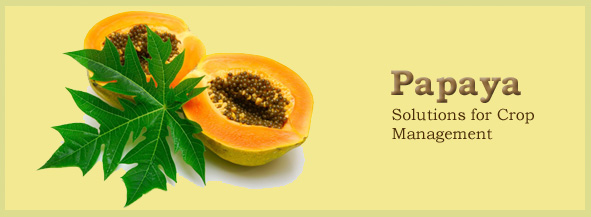
 Papaya is considered one of the most economically important and
nutritious fruits, being a rich source of antioxidant nutrients
such as carotenes, vitamin C and flavonoids; the B vitamins
folate and pantothenic acid; the minerals potassium, magnesium
and fiber.
Papaya is considered one of the most economically important and
nutritious fruits, being a rich source of antioxidant nutrients
such as carotenes, vitamin C and flavonoids; the B vitamins
folate and pantothenic acid; the minerals potassium, magnesium
and fiber. 
 .
When N deficiency is severe, all of the leaves turn yellow, new
leaves have slimmer stems and leaf laminas are not well
developed. Application of excess N without balancing amounts of
P and K would result in over vegetative growth, with a greater
distance between fruits on the trunk and inconsistent quality of
the pulp. The TSS of the fruit pulp reduces and the fruit become
over soft on ripening.
.
When N deficiency is severe, all of the leaves turn yellow, new
leaves have slimmer stems and leaf laminas are not well
developed. Application of excess N without balancing amounts of
P and K would result in over vegetative growth, with a greater
distance between fruits on the trunk and inconsistent quality of
the pulp. The TSS of the fruit pulp reduces and the fruit become
over soft on ripening.  Hence
basal application of phosphorus helps in better crop
establishment. The deficiency of P causes reduced leaf
production, complete cessation of elongation and older leaves
becoming increasingly irregularly necrotic. P deficiency causes
a blue or dark green coloration of leaves. Marginal chlorosis
and premature death are also caused. P deficient trees bear
fewer fruits and hence also suggested that P has an effect on
setting the fruit.
Hence
basal application of phosphorus helps in better crop
establishment. The deficiency of P causes reduced leaf
production, complete cessation of elongation and older leaves
becoming increasingly irregularly necrotic. P deficiency causes
a blue or dark green coloration of leaves. Marginal chlorosis
and premature death are also caused. P deficient trees bear
fewer fruits and hence also suggested that P has an effect on
setting the fruit.
 Plants
raised on P deficient nutritive solution resulted in P
deficiency symptoms initially in the oldest leaves, which have
amottled yellow color along the edges. As deficiency progresses,
the yellow areas become necrotic and the leaves have pointed
lobes while the edges curlupwards. Later, the leaves turn
completely yellow and fall from the trunk. New leaves are
smaller and have a dark green coloring.
Plants
raised on P deficient nutritive solution resulted in P
deficiency symptoms initially in the oldest leaves, which have
amottled yellow color along the edges. As deficiency progresses,
the yellow areas become necrotic and the leaves have pointed
lobes while the edges curlupwards. Later, the leaves turn
completely yellow and fall from the trunk. New leaves are
smaller and have a dark green coloring.  A
ratio of N:K2O of 1:1 seems to be the most favorable
to obtain good yields,which suggests that the fertilizers used
should have N:K2O ratios close to 1:1. Potassium
deficiency appears first in the oldest leaves and under severe
deficiency the leaves are shed resulting in a decrease in their
number and the remaining leaves positioned obliquely to the
trunk.
A
ratio of N:K2O of 1:1 seems to be the most favorable
to obtain good yields,which suggests that the fertilizers used
should have N:K2O ratios close to 1:1. Potassium
deficiency appears first in the oldest leaves and under severe
deficiency the leaves are shed resulting in a decrease in their
number and the remaining leaves positioned obliquely to the
trunk.
 Deficiency
results in marked reduction in growth, leaves profusely smaller,
leaf margins necrosis and premature yellowing of plant. Purplish
brown patches appear at the base of the petioles. Fruits are
badly shaped, poorly filled and unsuitable for marketing.
Deficiency
results in marked reduction in growth, leaves profusely smaller,
leaf margins necrosis and premature yellowing of plant. Purplish
brown patches appear at the base of the petioles. Fruits are
badly shaped, poorly filled and unsuitable for marketing.
 The
oldest leaves may also become yellow between the veins and
along the edges with a slight marginal necrosis on the
extremities of the lobes. The leaves tend to dry from the tip to
the centre. The developing leaves show chlorotic edges with
small necrotic spots. When K deficiency is severe the growing
point is affected
The
oldest leaves may also become yellow between the veins and
along the edges with a slight marginal necrosis on the
extremities of the lobes. The leaves tend to dry from the tip to
the centre. The developing leaves show chlorotic edges with
small necrotic spots. When K deficiency is severe the growing
point is affected 
 This
chlorosis extends back to the youngest leaves and the affected
leaves have twisted and folded stems. Calcium deficiency is also
responsible for premature ripening of fruits on the tree leading
to loss of fruits and softening of the fruit pulp, which results
in problems in transport and a short commercial shelflife.
This
chlorosis extends back to the youngest leaves and the affected
leaves have twisted and folded stems. Calcium deficiency is also
responsible for premature ripening of fruits on the tree leading
to loss of fruits and softening of the fruit pulp, which results
in problems in transport and a short commercial shelflife.  The
reasons for the emergence of magnesium deficiency in papaya is
both soil and plant based problems. Soil magnesium levels are
depleting without external additions. Fertilizer application
pattern skewed towards potassium causes imbalance between Mg and
K. This is a major reason for the appearance of Mg deficiency
in papaya.
The
reasons for the emergence of magnesium deficiency in papaya is
both soil and plant based problems. Soil magnesium levels are
depleting without external additions. Fertilizer application
pattern skewed towards potassium causes imbalance between Mg and
K. This is a major reason for the appearance of Mg deficiency
in papaya.
 Intensive
cultivation with high yield targets through modified fertilizer
application through drip using Mg free fertilizers fails to meet
the Mg requirement of the plants leading to Mg deficiency.
Magnesium deficiency results in the mature leaves having an
intense yellow color, while the regions in the proximity of the
veins remain green. When Mg is very deficient, the new leaves
also have similar symptoms.
Intensive
cultivation with high yield targets through modified fertilizer
application through drip using Mg free fertilizers fails to meet
the Mg requirement of the plants leading to Mg deficiency.
Magnesium deficiency results in the mature leaves having an
intense yellow color, while the regions in the proximity of the
veins remain green. When Mg is very deficient, the new leaves
also have similar symptoms.  When
sulphur is deficient, new, expanding leaves are light green in
color before becoming uniformly yellow. With increasing
deficiency, the completely expanded leaves also become yellow.
Before the appearance of visual symptoms in the leaves, the
growth of the papaya plant is affected. Sulphur uptake may also
be affected by the presence of chloride ions added to soil in
fertilizer.
When
sulphur is deficient, new, expanding leaves are light green in
color before becoming uniformly yellow. With increasing
deficiency, the completely expanded leaves also become yellow.
Before the appearance of visual symptoms in the leaves, the
growth of the papaya plant is affected. Sulphur uptake may also
be affected by the presence of chloride ions added to soil in
fertilizer.  Low
zinc levels also reduces fruit number per tree and to a lesser
extent the fruit size, resulting in decreased yields. Zinc
deficiency is seen in the expanding leaves as interveinal
chlorosis that later become purple spots.
Low
zinc levels also reduces fruit number per tree and to a lesser
extent the fruit size, resulting in decreased yields. Zinc
deficiency is seen in the expanding leaves as interveinal
chlorosis that later become purple spots.
 With
increasing deficiency, the youngest leaves remain small,
possibly showing necrosis along the edges and on the lamina
between the principal veins. The internodal space is also
shortened. Zinc deficiency included pronounced raised light
green veins on the upper and lower leaf surface distorted strap
like leaf lobes and slight yellowing of youngest leaves.
With
increasing deficiency, the youngest leaves remain small,
possibly showing necrosis along the edges and on the lamina
between the principal veins. The internodal space is also
shortened. Zinc deficiency included pronounced raised light
green veins on the upper and lower leaf surface distorted strap
like leaf lobes and slight yellowing of youngest leaves. Leaves also show typical gallery type interveinal chlorosis on
younger and recently mature leaves.
Leaves also show typical gallery type interveinal chlorosis on
younger and recently mature leaves.
 Leaves
desiccate prematurely causing poor fruit development. Manganese
supply is very restricted under dry conditions. If plants face
manganese deficiency, under such circumstances, normal size
fruit is produced by the plant but the fruits are covered with
raised dark brown or black spots.
Leaves
desiccate prematurely causing poor fruit development. Manganese
supply is very restricted under dry conditions. If plants face
manganese deficiency, under such circumstances, normal size
fruit is produced by the plant but the fruits are covered with
raised dark brown or black spots.  Leaves
may become yellow-white. The chlorosis is more acute in the
months of March-April and continues till rains are received and
may reappear after soils dry in post monsoon period before onset
of winter. In most of the areas deficiency gets corrected
during rainy season. It is also expressed on trees grown on
alkaline and calcareous soils soon after rains after a dry spell
because of increase in the bicarbonate content in the soil
solution.
Leaves
may become yellow-white. The chlorosis is more acute in the
months of March-April and continues till rains are received and
may reappear after soils dry in post monsoon period before onset
of winter. In most of the areas deficiency gets corrected
during rainy season. It is also expressed on trees grown on
alkaline and calcareous soils soon after rains after a dry spell
because of increase in the bicarbonate content in the soil
solution.  Best
expression of boron deficiency is seen on fruits with complete
misshapen fruits with tumor like appearance on surface of
fruits. When B deficiency is severe, the growing points of both
stems and roots are affected, the fruits are poorly formed and
latex drains from distinct points on the skin because of leakage
of potassium from cell membranes. Newer leaves are distorted and
the growing point dies. Leaves show chlorotic symptom with
inward cupping with stunted growth. Shoot show bushy appearance.
Best
expression of boron deficiency is seen on fruits with complete
misshapen fruits with tumor like appearance on surface of
fruits. When B deficiency is severe, the growing points of both
stems and roots are affected, the fruits are poorly formed and
latex drains from distinct points on the skin because of leakage
of potassium from cell membranes. Newer leaves are distorted and
the growing point dies. Leaves show chlorotic symptom with
inward cupping with stunted growth. Shoot show bushy appearance.
 Additional
symptoms of B deficiency are that flowers abort in periods of
drought, fruits alternate on the trunk, leaves are yellow with
short stems and the vascular system may or may not appear
darker. Once a plant shows signs of deficiency it cannot fully
recover. The symptoms are generally confused with ring spot
virus infection.
Additional
symptoms of B deficiency are that flowers abort in periods of
drought, fruits alternate on the trunk, leaves are yellow with
short stems and the vascular system may or may not appear
darker. Once a plant shows signs of deficiency it cannot fully
recover. The symptoms are generally confused with ring spot
virus infection.